ASUS Z97-DELUXE (NFC & WLC) Review: With Two Thunderbolt 2 Too
by Ian Cutress on May 16, 2014 11:00 AM EST- Posted in
- Motherboards
- Intel
- Asus
- NFC
- 802.11ac
- Thunderbolt 2
- Z97
- Wireless Charging
Real World CPU Benchmarks
Readers of our motherboard review section will have noted the trend in modern motherboards to implement a form of MultiCore Enhancement / Acceleration / Turbo (read our report here) on their motherboards. This does several things – better benchmark results at stock settings (not entirely needed if overclocking is an end-user goal), at the expense of heat and temperature, but also gives in essence an automatic overclock which may be against what the user wants. Our testing methodology is ‘out-of-the-box’, with the latest public BIOS installed and XMP enabled, and thus subject to the whims of this feature. It is ultimately up to the motherboard manufacturer to take this risk – and manufacturers taking risks in the setup is something they do on every product (think C-state settings, USB priority, DPC Latency / monitoring priority, memory subtimings at JEDEC). Processor speed change is part of that risk which is clearly visible, and ultimately if no overclocking is planned, some motherboards will affect how fast that shiny new processor goes and can be an important factor in the purchase.
Rendering – Adobe After Effects CS6: link
Published by Adobe, After Effects is a digital motion graphics, visual effects and compositing software package used in the post-production process of filmmaking and television production. For our benchmark we downloaded a common scene in use on the AE forums for benchmarks and placed it under our own circumstances for a repeatable benchmark. We generate 152 frames of the scene and present the time to do so based purely on CPU calculations.
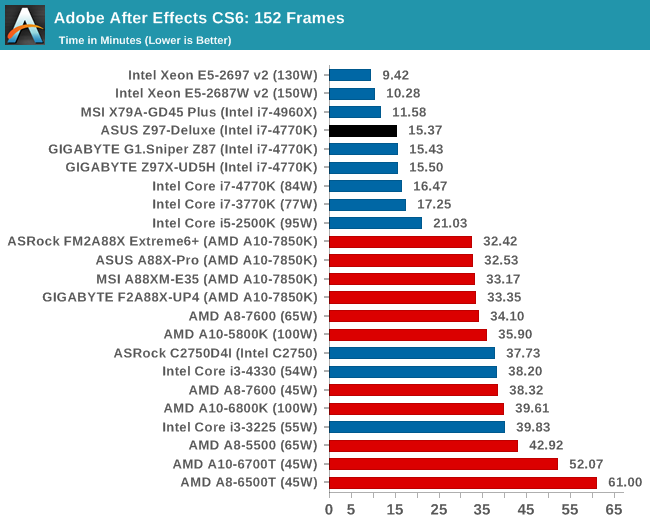
Compression – WinRAR 5.0.1: link
Our WinRAR test from 2013 is updated to the latest version of WinRAR at the start of 2014. We compress a set of 2867 files across 320 folders totaling 1.52 GB in size – 95% of these files are small typical website files, and the rest (90% of the size) are small 30 second 720p videos.
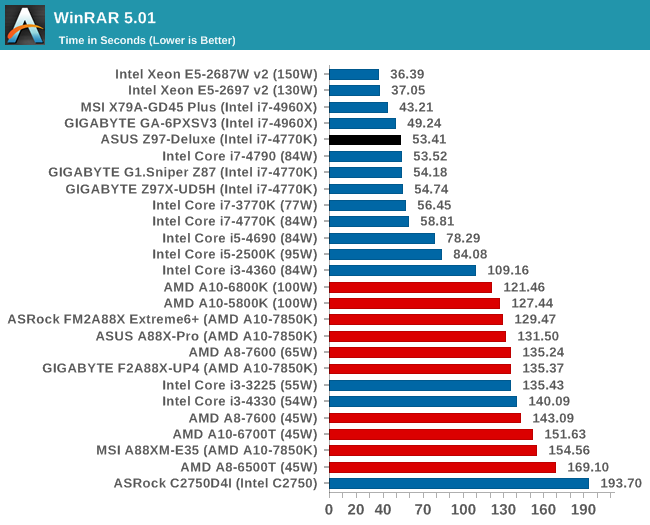
Image Manipulation – FastStone Image Viewer 4.9: link
Similarly to WinRAR, the FastStone test us updated for 2014 to the latest version. FastStone is the program I use to perform quick or bulk actions on images, such as resizing, adjusting for color and cropping. In our test we take a series of 170 images in various sizes and formats and convert them all into 640x480 .gif files, maintaining the aspect ratio. FastStone does not use multithreading for this test, and thus single threaded performance is often the winner.
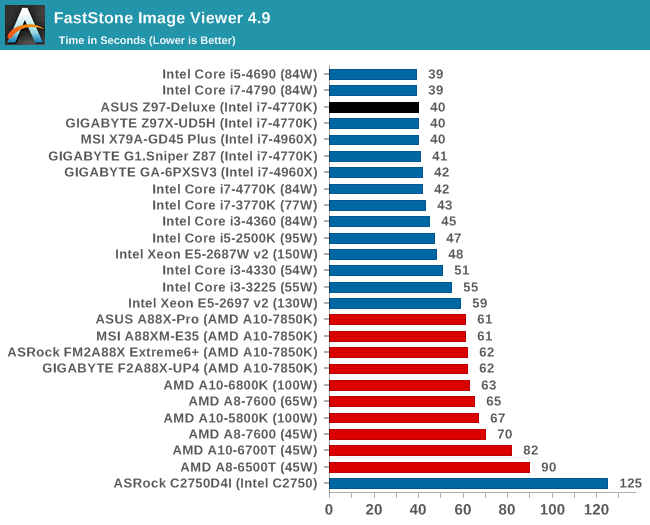
Video Conversion – Xilisoft Video Converter 7: link
The XVC test I normally do is updated to the full version of the software, and this time a different test as well. Here we take two different videos: a double UHD (3840x4320) clip of 10 minutes and a 640x266 DVD rip of a 2h20 film and convert both to iPod suitable formats. The reasoning here is simple – when frames are small enough to fit into memory, the algorithm has more chance to apply work between threads and process the video quicker. Results shown are in seconds and time taken to encode.

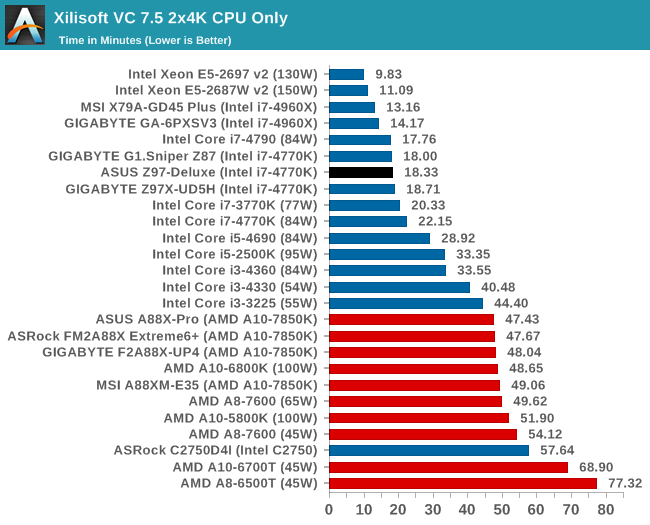
Video Conversion – Handbrake v0.9.9: link
Handbrake is a media conversion tool that was initially designed to help DVD ISOs and Video CDs into more common video formats. The principle today is still the same, primarily as an output for H.264 + AAC/MP3 audio within an MKV container. In our test we use the same videos as in the Xilisoft test, and results are given in frames per second.

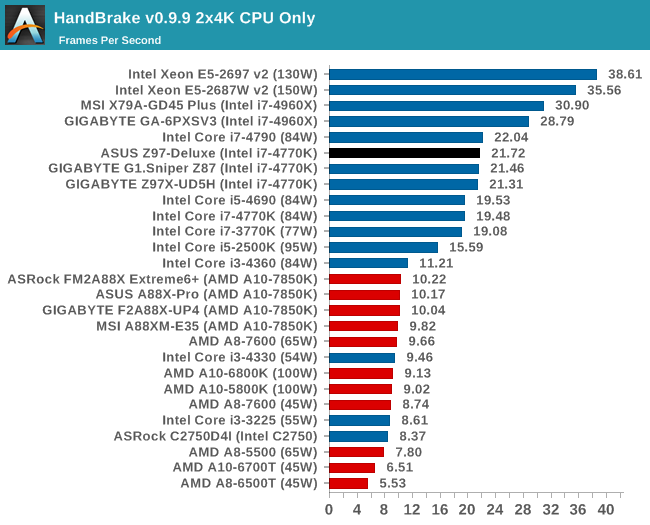
Rendering – PovRay 3.7: link
The Persistence of Vision RayTracer, or PovRay, is a freeware package for as the name suggests, ray tracing. It is a pure renderer, rather than modeling software, but the latest beta version contains a handy benchmark for stressing all processing threads on a platform. We have been using this test in motherboard reviews to test memory stability at various CPU speeds to good effect – if it passes the test, the IMC in the CPU is stable for a given CPU speed. As a CPU test, it runs for approximately 2-3 minutes on high end platforms.
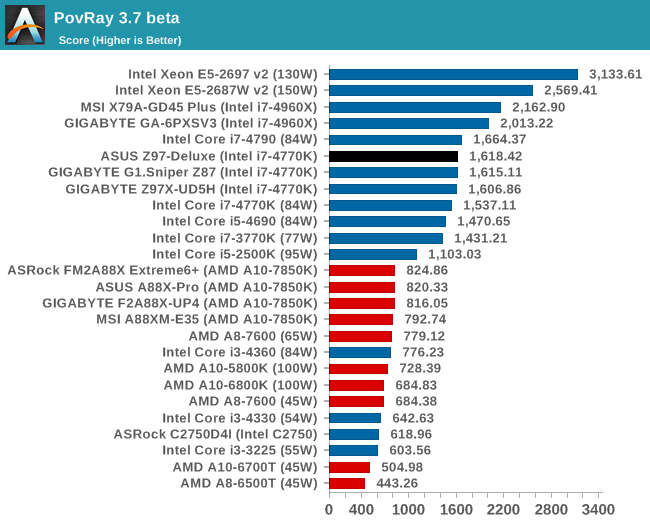










45 Comments
View All Comments
aron9621 - Saturday, May 17, 2014 - link
The Z87 Deluxe Quad uses a PLX switch (a PEX8608 I believe) for the PCI Express 2.0 lanes coming from the chipset. It's a shame given the price category the Z97 Deluxe doesn't do the same and limits the simultaneous usage of the SATA Express/M2/Thunderbolt ports.UltraWide - Friday, May 16, 2014 - link
Fan curve control from the BIOS, this is worth the GOLD color! WOW I have been waiting for such a feature for the past 10 years.ASUS you got my money and vote. :thumbsup: x 2
OuchIAteMyself - Friday, May 16, 2014 - link
It has been worth it for me to pay more for these premium motherboards. I'm using a P5B Deluxe bought in 2006 to post this comment and it's still going strong. ASUS even released a BIOS update that allowed me to upgrade to a Q9550 processor which is fairly modern. I'll buy ASUS again when I build a new system within the year.pt2501 - Friday, May 16, 2014 - link
LOL I had that the P5B Deluxe for 5 years and thought it was simple, powerful, and rock solid. For the price it offered up the best overclocking and when I built it in late 2006 I paired it with the lowest of the then new core 2 duo (1.6 GHz model). It received a plethora of updates that allowed it to later upgrade to use the top the Cord 2 Duos/Quad cores. I later put in a 3.0 Ghz duo core with the added cache for better performance and maxed out the Ram capacity without any loss of stability. The board never failed I eventually recycled it for lack of anyone wanting a desktop. Now i run an older P8Z68-V Pro/Gen3 with an i5 2500K. The support from Asus for all my boards has been outstanding.I felt like I ponied up alot more cash for this board but the difference in all the features more than pays for itself over time. UEFI, 4 way SLI/Crossfire/TPU/EPU: you can literally do anything with this board and I have never felt like I was missing out on anything.
Most likely unless Asus starts making garbage, if you buy one of their boards my experience has been that you can use it until the subsequent technology becomes completely obsolete.
AssBall - Sunday, May 18, 2014 - link
The DELUXE set from Asus has always been top notch and rock solid. My first build ever was Lots of overclocking and tweaking options. The power delivery is some of the best in the industry, IMO. The new UEFI BIOS's are sweet to work with. Now they also put some decent integrated sound processors on the boards too, which adds a ton of value in my book.Their Pro stuff is really good too if you want a simple overclock system or a 24/7 workstation. The only thing better than an ASUS board is a new ASUS board, heh.
jibz - Friday, May 16, 2014 - link
Nice review. I like the fact that you added audio benchmarks. What I'd like to see included are the numbers for a good add-on card, if only to establish some kind of upper echelon. I understand that it's not fair to compare a 300$ sounds card to the one included on a 300$ motherboard, but it'd help to put the numbers in perspective.cjs150 - Friday, May 16, 2014 - link
Lovely looking board but someone needs their head examined on the storage.This is a top end board it should be capable of having a big GPU, m2 drive as boot drive and ultra fast storage via thunderbolt
xeizo - Friday, May 16, 2014 - link
You could say I use only Asus DeLuxe mobos as I have both the P5Q-DeLuxe and the P8Z68-DeLuxe/G3 currently up and running ;-)The P5Q-DeLuxe has been running since 2008 and 24/7 for the last three years(web/music/movie/nas-server). The P8Z68 is the gaming/development/music production/workstation and performs admirably with dual SSD:s, 16GB RAM and a single GTX770(as I only use 1080P). Very happy with these mobos, 4xUSB3 and 4xSATA6 is very usable on the P8Z68, good for being from 2011 ... It also has no problems remaining stable above 5GHz on water with 8x100% load like forever ....
However, next mobo will be made for Haswell-E with ZX99(?), Z97 is too much of a sidegrade and more cores is good to have when compiling. Higher clocked Xeons are only damned expensive :(
wwwcd - Friday, May 16, 2014 - link
Board FeaturesASUS Z97-Deluxe (NFC + WFC)
...........
Chipset Intel Z87
...........
WoW :D
Ian Cutress - Friday, May 16, 2014 - link
AHA! Re-using old table templates, thanks for the catch :D